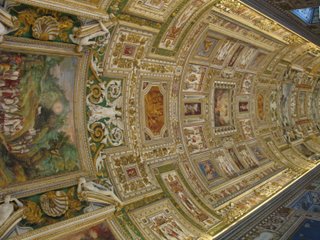We have made it interesting for this Roman guide. Yesterday we spent three or four hours in the Vatican, again, that wonderful world of curiosities. We came very near expressing interest, sometimes--even admiration--it was very hard to keep from it. We succeeded though. Nobody else ever did, in the Vatican museums.
The guide was bewildered-- non-plussed. He walked his legs off, nearly, hunting up extraordinary things, and exhausted all his ingenuity on us, but it was a failure; we never showed any interest in any thing. He had reserved what he considered to be his greatest wonder till the last--a royal Egyptian mummy, the best preserved in the world, perhaps. He took us there. He felt so sure, this time, that some of his old enthusiasm came back to him:
"See, genteelmen!--Mummy! Mummy!"
"Ah,--Ferguson--what did I understand you to say the gentleman's name was?"
"Name?--he got no name!--Mummy!--'Gyptian mummy!"
"Yes, yes. Born here?"
"No! 'Gyptian mummy!"
"Ah, just so. Frenchman, I presume?"
"No!--not Frenchman, not Roman!--born in Egypta!"
"Born in Egypta? Never heard of Egypta before. Foreign locality, likely. Mummy--mummy. How calm he is--how self-possessed. Is, ah--is he dead?"
"Oh, sacre bleu, been dead three thousan' year!"
from Innocents Abroad, Mark Twain, 1869

 the first sovereigns who opened the art collections of their palaces to the public thus promoting knowledge of art history and culture.
the first sovereigns who opened the art collections of their palaces to the public thus promoting knowledge of art history and culture.The museum has works of art by painters Michelangelo, Raphael and Fra Angelico, but my favorite part of the museums is the Gregorian Egyptian Museum.

The mummies in their sarcophagi are the real attraction of the Museum, especially that of a princess of the 21st Dynasty, whose hair is dyed with red henné (see above). In the next room, characterized by the starry roof, the Serapeo, with its basalt Roman statues, which imitate the Egyptian ones, has been rebuilt in part. The scene represents the solar awakening of Osiride-Apis, who emerges from a lotus flower, in front of a canal which represents the Nile. Osiride’s face is that of Antinoo, the emperor’s favorite, who died in the Nile.
Other parts of the Vatican Museums and Collections include:
- Near Eastern Antiquities
- Alexandria and Palmyra
- Antiquities from Palestine
- Room of the Assyrian relief sculptures
- Gregorian Etruscan Museum
- Antiquarium romanum
- Collection of vases
- Classical Antiquities (Greek and Roman)
- Pio Christian Museum (with the Christian and Hebrew Lapidary)
- Pinacoteca (picture gallery)

- Tapestries
- Ceramics (18th-19th century)
- Miniature mosaics
- Collection of Modern Religious Art
- Missionary-Ethnological Museum
- Museo Sacro (formerly part of the Vatican Library)
- Gregorian Profane Museum
- Belvedere Palace
- Upper Galleries (Gallery of the Candelabra; of Tapestries and of Maps)
- Apartment of St. Pius V
- Sala delle Dame
- Room of the Immaculate Conception
- Raphael Stanze

- Room of the Chiaroscuri
- Chapel of Nicholas V
- Chapel of Urban VIII
- Sistine Chapel
- Borgia Apartment
- Salone Sistino
- Room of the Aldobrandini Wedding
- Lower Galleries (Urban VIII, Alexandrine, Clementine)
 Of course, you can't take pictures in the Sistine Chapel. Well, I guess you could, but it would be as risky as bringing cheese home in your suitcase. You could do it, but a uniformed guard might come to take you away. You can, however, take pictures in some of the other areas of the Museums. During my visit to the Vatican Egyptian Museum, it was mentioned, by a source that will go unnamed by me, The Museum of Egyptian Antiquities in Cairo would like to have some of their antiquities 'returned'. Italian authorities are apparently 'making excuses and dragging their feet'. I've seen Romans make excuses AND drag their feet.
Of course, you can't take pictures in the Sistine Chapel. Well, I guess you could, but it would be as risky as bringing cheese home in your suitcase. You could do it, but a uniformed guard might come to take you away. You can, however, take pictures in some of the other areas of the Museums. During my visit to the Vatican Egyptian Museum, it was mentioned, by a source that will go unnamed by me, The Museum of Egyptian Antiquities in Cairo would like to have some of their antiquities 'returned'. Italian authorities are apparently 'making excuses and dragging their feet'. I've seen Romans make excuses AND drag their feet.





No comments:
Post a Comment